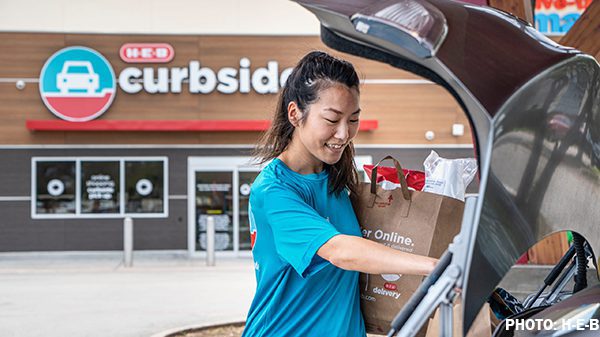Two weeks ago, I checked in with Bill Bishop of Brick Meets Click about consumer demand for online grocery as we saw just a glimpse of what would happen with coronavirus/COVID-19.
Bishop, chief architect for the Barrington, IL-based consultancy specializing in e-commerce, told me the “good news is that most grocers have a fair amount of unused capacity to fulfill online grocery order so, at least initially, there will be no service delays.”
“There will, however, be the impact of out-of-stocks caused by the stocking up that is taking place in store,” he said.
Boy, that escalated quickly.
Online orders actually crashed Ocado’s service in the U.K., and the online service started limited orders to existing customers amid unprecedented demand.
As of today, March 20, the next available time slot for me to order curbside or delivery for H-E-B is Friday, April 3.
Walmart’s grocery here in Cedar Park, TX, is a little less swamped, with order slots available next-day, but no guarantees what I want is in stock.
Given what’s going on with consumers in-store, I’m not surprised that that online is experiencing hiccups as well. Out-of-stocks are an inconvenience, but not a deal-breaker in the current climate, Bishop says.
“Consumers understand how this happens and tend to blame other consumers, not the grocer,” he said.
Those of us in the grocery world understand that it will take a while for out-of-stocks to even out (as soon as consumers stop panic-buying, that is…)
Never mind the out-of-stocks, what’s next?
But what’s next in a world where people may be homebound longer than expected?
What Brick Meets Click has learned is that there are more barriers to first-time online grocery shoppers than many would have expected.
“They relate largely to lack of experience using the computer or mobile phone, in this type of application,” he said. “These hurdles can be easily overcome by the retailer once they’re aware a problem exists, but in many instances they’re just not aware.”
Brick Meets Click outlined some of the issues retailers are having as they’re swamped with online grocery orders in this post, “How will COVID-19 affect growth of online grocery? What can retailers do to improve the experience”.
They asked an older shopper to allow them to observe her first-time experience for a video and found the shopper had problems locating the search function, filtering responses, substitutions, adding items to the cart and where to get help if you’re stuck or overwhelmed.
I’m 40 years old. I started using computers in kindergarten and even I get stuck on retailer e-commerce sites, particularly on my mobile phone.
Brick Meets Click suggests adding a “welcome guide” tutorial for new online shoppers, especially ones that are not familiar with how to shop for groceries online.
In lieu of a “senior shopping hour,” H-E-B just launched a new service for seniors to make placing orders easier through a Senior Support Line which allows those 60 and older to call a dedicated line and order from a curated list of essentials. The fee is waived for the first 30 days, with a $10 tip to the Favor runner.
Once this all blows over, I’m sure a segment of the market will continue to order groceries online, but I’m also betting a lot of people stuck at home with nothing to do and nowhere to go will relish the idea of getting out and going to the store.
I know in my house we’ll be fighting over who gets to get out over the next couple of weeks.



